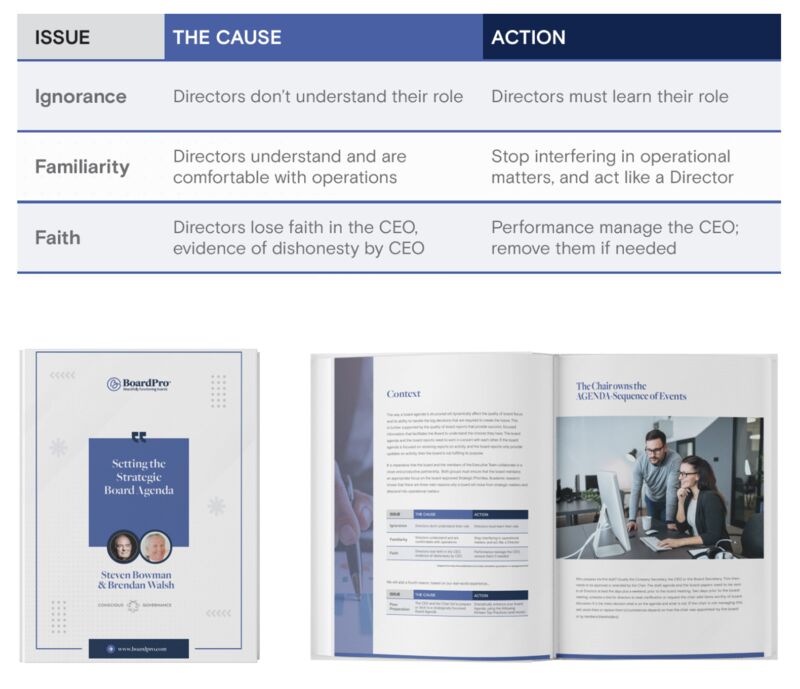The role of consent agendas in board meetings
Board meetings are busy, so any steps to make them more efficient are a welcome addition to the workflow. Streamlining board activities, such as agendas, frees up valuable time for more complex and strategic discussions. A 'consent agenda' is one way to ensure time is well spent and the board practices good governance.
What is a consent agenda?
A consent agenda consists of grouping routine business and reports into a single agenda item. Doing this allows one whole board agenda to be approved as one, rather than having to approve different motions separately.
The main advantage of a consent agenda is that it allows the board to conduct its routine business quickly and efficiently, leaving more time for discussion on more complex or demanding issues.
Why is a board consent agenda important?
Typically, the board agenda and relevant board papers are sent out five working days prior to the board meeting, to give directors time to read, understand, and ask clarification questions prior to the actual meeting,' says Steven Bowman, seasoned board advisor and managing director of Conscious Governance.
Board members review items on the consent agenda and decide if they agree with what is proposed. If a board member feels an item needs further discussion, they are able to request it be removed from the consent agenda.
“The consent agenda technique is a powerful tool that reduces the amount of time spent on reports that are 'for noting only'. It is called a consent agenda as the board formally 'consents' to not spend time on items that are 'for noting only'. This is sometimes called a block agenda (where a group of items are placed together and approved by the board as a ’block’). These 'for noting only' board agenda items will be voted to be accepted as a group (or as a block item). Anecdotally, chairs have noted that this can reduce the time of board meetings by up to 30%, leaving more time for strategic discussions,” says Bowman.
What does a consent agenda include?
Three different report styles go into a consent agenda — those for decision making, discussion, and noting only. The vast majority of them are for noting only or for information. For the most part, consent agendas are a collective of routine, self-explanatory, non-controversial matters of the board that need to be noted but are not necessarily discussed during meetings.
These items may include (but are not limited to):
- routine policy revisions
- CEO report
- financials
- standard contracts that are regularly used
- the minutes of previous board meetings
- committee reports
- office reports
- final decision approval of proposals that have already been discussed in detail
- 'information only' reports
Can you make changes to the consent agenda?
“Up to 48 hours before the meeting, board directors may request that the chair take an item off the consent agenda item so that it can be discussed by the full board,” says Bowman.
“It is at the discretion of the chair whether to allow the item to be moved onto the agenda for discussion (or not). This technique separates out matters that the chair and CEO believe are not worthy of any discussion, usually only reports on progress or information with no action required.”
If the chair is not convinced by a director’s request to have the item discussed, then the chair can still recommend that all ‘consent agenda items are accepted as they appear in the Agenda,' Bowman adds.
It's important that the 'consent agenda' approach is used judiciously to ensure that significant items are not overlooked or rushed through without proper scrutiny.
Boost board meeting productivity
The use of a consent agenda is a common practice in many organisations to ensure that board meetings are more productive and focus on matters that require in-depth consideration. It is a valuable tool that saves time — so directors can focus on the more critical aspects of a meeting.
Download a free white paper Setting the Strategic Board Agenda here
When you're ready here's how BoardPro can help
Start a Free Trial — run a whole board meeting cycle for free, no credit card needed. You’ll be able to create board packs in a click, and have all minutes, decisions, actions and interests in one place. Be more effective, save time, and have everyone on the same page! Book a Demo — see BoardPro in action in this 30-minute demo, and have all your questions answered by a BoardPro specialist. You’ll get an introduction to all of BoardPro’s features — see how to set an agenda, create board packs, and take minutes. Attend a Free Governance Webinar — learn from our community of governance experts on subjects such as strategy, understanding board dynamics, reporting, and running effective meetings. You’ll join hundreds of others in these engaging events covering the latest governance topics. Find a Governance Template — practical documents to make governance easy! Templates cover strategic planning, board evaluation, risk assessment, SWOT analysis, and many other essential governance and business topics to grow your organisation and adopt good governance practices. |
Share this
You May Also Like
These Related Stories

How to create a strategic board meeting agenda
%20(1).png)
How to build a strategic board agenda
.png)


